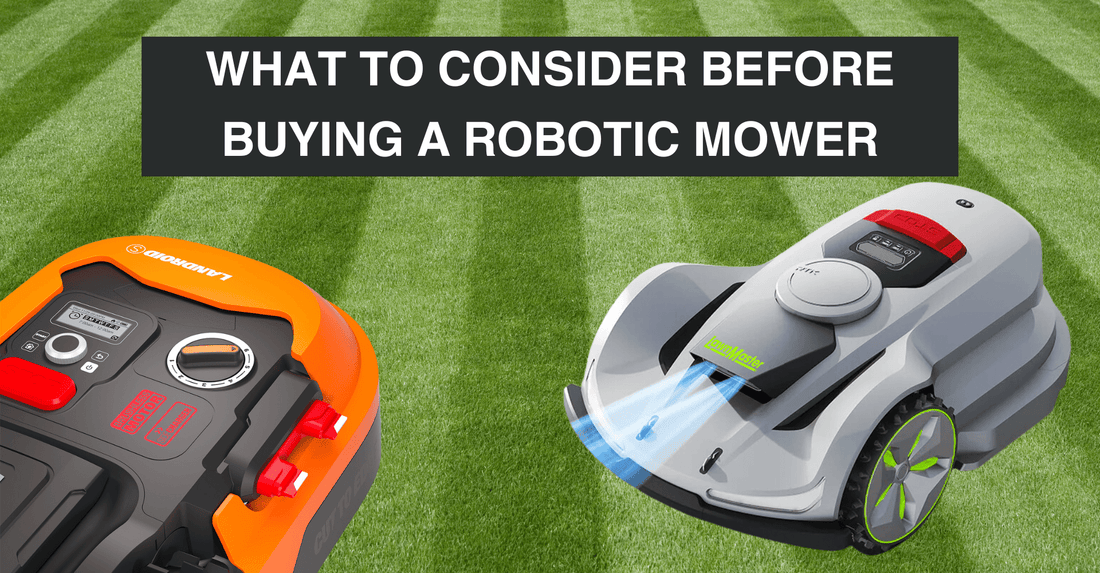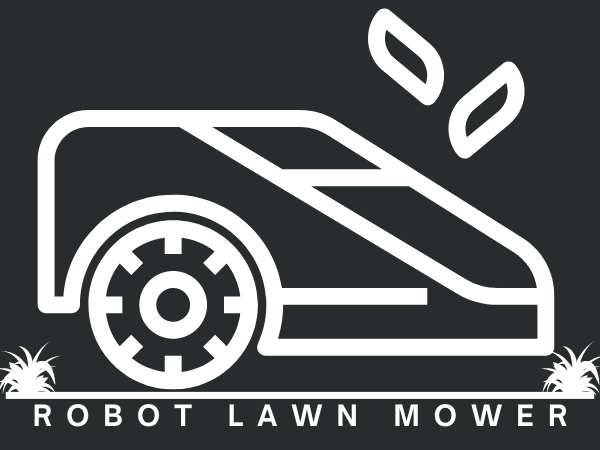
What to Consider Before Buying a Robotic Lawn Mower
Before purchasing a robotic mower, there are a number of factors that must be considered and assessed against the user’s specific lawn condition to determine suitability and practicality. Choosing the latest model or the highest-priced robotic mower, may not necessarily be the right fit for your lawn, or give the desired results.
Below we will discuss factors such as lawn size, terrain, slopes and how to calculate these, budget, and desired features, helping you make an informed decision that aligns with your lawn’s unique needs.
What is your lawn type and terrain?
Lawn type and terrain must be considered before purchasing a robotic lawn mower. Different model robotic mowers have varying capabilities in terms of coverage area and ability to navigate specific terrain. For example, if you have a small 500m2 lawn but the majority of the lawn is sloping, the mower will need to work harder, draining its battery faster and taking more time to complete the job. In this case, opting for a larger, more powerful model might be a better option to ensure it can handle the capacity and terrain efficiently.
Rye-Fescue Blend:
This lawn type is hard-wearing and quick to establish, it suits a wide range of environments
Fine Fescue:
Hardy and shade-tolerant grass, it has the ability to regenerate itself after harsh summers, doesn’t like regular foot traffic
Tall Fescue:
Hard-wearing, drought tolerant and copes well in high-traffic areas
The Worx and LawnMaster robotic mowers both feature 3 blades ensuring a clean and precise cut. Compared to the Ambrogio mower which has a single operating blade making it less versatile to New Zealand lawns and may incur a higher replacement cost. The three blades are better suited to handle the demands of New Zealand lawn conditions.
While lawn type is important, it is equally important to consider the complexity of the terrain, including factors such as lawn size, uneven surfaces, and obstacles.
Can Robot mowers cut around trees?

Yes, robotic mowers can cut around trees however, there are two points to consider.
Wireless Robot Mowers:
Wireless robot lawn mowers need good satellite connection to navigate, if the trees have foliage, it could block the signal. This can affect the mower's ability to operate efficiently.
Large protruding roots and fallen fruit:
If your trees have large protruding roots or drop a lot of fruit, this can pose challenges. The roots may cause the robot mower to get stuck, while the fallen fruit could clog the blades or even cause damage.
Robotic mowers come equipped with advanced sensors that enable them to detect obstacles, these obstacles must be large enough for the sensors on the robot mower to detect. Depending on your circumstances, you might choose to wire out the obstacles, or create no go zones in the app. If you are uncertain of the changes, or if the lawn is going to be evolving, a wireless robotic mower may be the optimal choice as making changes within the app is simple, quick and easy. Provided your lawn is suitable for a wireless robot mower.
What is the size of your lawn?
Size is important to consider when purchasing a robotic mower, you want to select a model that has capacity and will operate efficiently. It’s recommended you don’t exceed 70% of the robot’s maximum capacity, this is to get the best cutting results. If you have 700m2 of lawn, we recommend you choose a robot mower with a capacity of 1000m2
How to measure your lawn:
Your lawn can be easily measured through Google Maps.
- Google Maps -satellite
- Right-click “measure distance”
- Click on the map to trace your path.
Alternatively, this can be measured manually:
- Walk the length of your lawn, estimating one pace measures 0.9 metres.
- Pace the width of the lawn
- Multiply the length by the width to arrive at the total metres squared m2.
- Subtract the square footage of the house and driveway
Incline and Slope:

Slope and incline must be considered when purchasing a robotic lawn mower. Different mowers have varying capabilities when it comes to handling slopes and inclines. Steeper slopes require more power and traction to navigate. Mowers with inefficient traction or inadequate slope abilities may struggle to maintain stability, and may slide when changing direction.
Operating a mower beyond its capability can result in excessive strain on its motors, wheels and other components. The strain can lead to premature wear and tear affecting the overall lifespan and performance. Choosing a robotic mower suitable to your lawn ensures it operates within its limits, promoting longevity and minimising the need for frequent repair and replacements.
Robot Mowers have three different slope ratings:
Maximum permissible slope-
This determines the highest gradient value that the robot can manage. The highest slope should only be a small part of the lawn and it should be inside the perimeter wire.
Maximum consistent slope-
If most of the lawn is sloped, this should be the property’s maximum slope gradient value
Maximum edge slope -
This is the most important rating, the maximum slope allowed within 1 metre of the boundary wire.
Lawns with rough or uneven surfaces, and thick or deep grass (>30mm when cut) need to be factored into the maximum slope ratings.
Measuring the slope:
Measuring the slope of the lawn is important as robotic mowers have a measurement called their slope rating. The slope rating is displayed as a % gradient, the % gradient is not the same as degrees.
To measure the % gradient of the lawn:
- Use a level that is at least 100 cm long or a straight stick to rest your level on top
- Measure one metre from one end and make a mark on the level
- Place one end of the level on the ground and position the other end so the bubble shows it is level
- Measure from your mark on the level to the ground
- The measurement will be equal to the gradient in centimetres (cm).
- Xcm is equal to X% gradient.
Robotic mower repairs and maintenance cost?

Repairs and maintenance are crucial to consider when purchasing a robot lawn mower. It’s important to consider not only the upfront cost but also the long-term costs associated with operating and maintaining a robotic mower.
Robotic Lawn Mowers typically require battery replacements every 3-4 years. If the battery is difficult to access or encased in the mower, replacements can be costly as they will require servicing to change and can’t be done yourself. Models such as the Worx Robotic mowers offer interchangeable batteries that can be replaced conveniently, easily and affordably.
Evaluate the cost and frequency of cutting blade replacements. Different models have varying blade sizes and replacement requirements.
Servicing and after-sales support is crucial as some models may require regular servicing by an approved dealer to maintain their warranty. This can significantly increase long-term ownership costs. It’s essential to be aware of these requirements, as well as the potential for higher costs associated with certain models. Additionally, some brands require the mower to be shipped back to a service centre at the customer’s cost, because of the battery, robotic mowers are classed as dangerous goods which adds to the cost of shipping.
At Robot Lawn Mower NZ, we have service centres throughout NZ.
Do I need professional installation compared to DIY?
A key consideration when purchasing a robotic mower as mentioned previously is the ongoing costs associated and whether to opt for professional installation or take the DIY route. Worx and LawnMaster robotic mowers are the choice for New Zealand lawns, designed for Kiwi lawns and for our DIY nature. They are easy to install.
What should I consider before buying from Robot Lawn Mower?
Purchasing a robot lawn mower requires careful consideration of various factors to ensure that you make the right choice for your specific needs. Understanding your intended use, considering the type and terrain of your lawn, size of your lawn, accounting for inclines and obstacles, and assessing the ongoing maintenance costs are all important factors.
Robot Lawn Mower makes the process simple and easy with hassle-free robotic mowers that cater to the DIY nature of Kiwi homeowners. By carefully considering these factors, you can select the right robot lawn mower that will effortlessly maintain your lawn and provide you with a well-manicured, hassle-free outdoor space.
